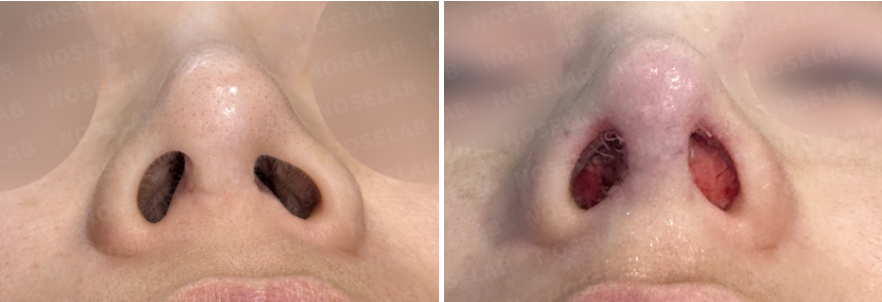Crooked Nose and Asymmetric Nostrils Correction with Closed Rhinoplasty
- noselab
- 2024년 8월 12일
- 3분 분량
최종 수정일: 9월 30일
Hello, this is Dr. Chayoung Kang, Director of Noselab Rhinoplasty Clinic. Today, I will present a case of crooked nose and asymmetric nostrils correction performed through closed rhinoplasty.
This patient had already undergone several rhinoplasty surgeries and visited Noselab for her fourth revision rhinoplasty. Her main concerns were a deviated nose tip, severe nostril asymmetry, and a wide, droopy nasal tip.
Preoperative Analysis for Crooked Nose and Asymmetric Nostrils Correction

Nose tip deviated to the right
Severe nostril asymmetry
Left alar appears pinched
Wide and droopy nose tip

Barely visible columella in between the alar.
Long philthrum.

Prominent deviation.
Wide and droopy nose tip.

The columella is pulled to the right side
The right nostril is smaller than the left one
Noticeably asymmetric nostrils
Surgical Techniques for Crooked Nose and Asymmetric Nostrils Correction
a) Autologous costal cartilage and septal reconstruction
The septal cartilage was lacking due to the previous surgery, so we reconstructed it using the self-rib cartilage.
Through the septal reconstruction we managed to fixate the shape and location of the nose tip.
b) Septal extension graft
Reinforcement and septal extension using the reconstructed septal cartilage.
Correction of the droopy nose tip by increasing the height of the structure of the nasal tip.
c) Septoplasty
Correcting the crooked nose through a septal deviation corrective surgery, as well as improving the patient’s respiratory function.
d) Submucous resection of the inferior turbinates
In order to improve the symptoms of rhinitis, we performed a submucosal resection of the inferior turbinates using a high-frequency laser.
e) Usage of the existing hip dermis
Careful removal and reusage of the dermis used in the previous surgery.
f) Correction of the nose tip.
Appropriate correction of the nose tip deviation using the reconstructed septal cartilage.
Shape improvement by raising the wide and droopy nose tip.
g) Correction of the nostril asymmetry
By straightening the nose tip, the nostril asymmetry improved in a natural-looking manner.
Every procedure was performed through the closed rhinoplasty approach, without leaving any external scars.
Before and After Surgery Photos

The right-sided deviation of the nose tip was corrected and the nose tip was straightened to be in the middle.
Great improvement of the previously severe nostril asymmetry.
The pinched appearence of the left side alar decreased.
The wide and droopy appearance of the nose tip became a more natural and better looking nose shape.

Adjustment of the columella for visibility in between the alar.
The philtrum lenght now appears to be visually appropriate.

The previously crooked nose was transformed into a smooth line.
By improving the wide and droopy nose tip, the appearance took on a more balanced look.

The columella skewed to the right side is now fixed straight in the middle.
The size and shape of both nostrils improved and look more similar.
After surgery table photos


Overview – Crooked Nose and Asymmetric Nostrils
This case is a good example of the relationship between asymmetric nostrils and a crooked nose. In many cases, nostril asymmetry is a secondary phenomenon caused by the tip of the nose being crooked to one side. Therefore, attempts to simply correct nostril asymmetry (e.g., nostril lowering surgery) are likely to fail to solve the fundamental problem.
In this patient’s case, the nostril asymmetry was naturally improved by correcting the crooked nasal tip. This shows how important it is to accurately identify the cause of the asymmetry and choose the appropriate correction method.
Furthermore, correcting the septal cartilage is very important to correct the tip of the nose. This is an area where otolaryngologists are particularly specialized. In this case, septal cartilage reconstruction using autologous costal cartilage played a key role in achieving a successful outcome.
I hope this case was helpful to those concerned about a crooked nose and asymmetric nostrils. The important thing to note is that not all crooked nose corrections are done in the same way. The appropriate correction method may vary depending on each patient’s condition and depending on the cause of the deviation.
Therefore, it is important to accurately understand your condition through consultation with a specialist and establishing the optimal surgical plan based on it. Based on its rich expertise, Noselab Rhinoplasty Clinic provides the most suitable solution for each patient.
With Noselab Rhinoplasty Clinic you can achieve a beautiful and healthy nose.
Thank you.
Noselab Rhinoplasty Clinic
Dr. Chayoung Kang.

Messenger(WhatsApp) : +82 1057360302
Home page : www.noselab.co.kr
Instagram : noselab_global
YouTube : Noselab
Email : noselab@naver.com



댓글